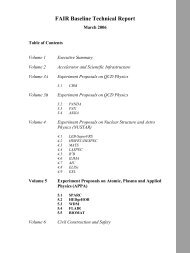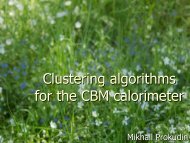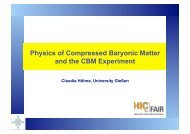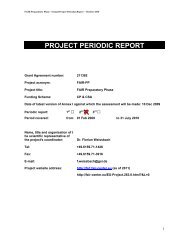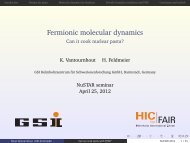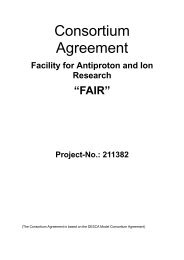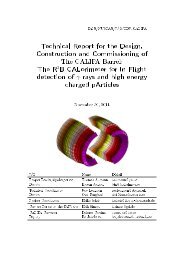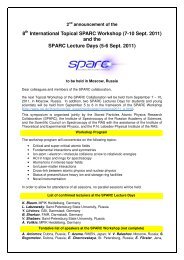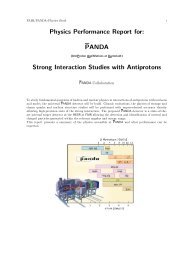NeuLAND - FAIR
NeuLAND - FAIR
NeuLAND - FAIR
Create successful ePaper yourself
Turn your PDF publications into a flip-book with our unique Google optimized e-Paper software.
at the surface of the nucleus. The reaction solely probes the tail of the wave function.<br />
The fraction of the density to which the reaction is sensitive, depends strongly on the<br />
separation energy. In the extreme case of a weekly bound neutron, i.e., knockout of<br />
a halo neutron, this fraction is rather large, e.g., in the order of 50% for knockout of<br />
the 2s neutron from 11 Be. The higher the separation energy and the larger the angular<br />
momentum, the smaller the fraction, which approaches values of only a few percent for<br />
cases where the largest reduction has been found.<br />
Since electron-induced knockout reactions cannot be realized at present with short-lived<br />
nuclei, proton-induced knockout reactions are an alternative. High beam energies have<br />
the advantage that the nucleon-nucleon cross section is small, causing some transparency<br />
of the nucleus which makes the reaction more sensitive to the inner part of the nucleus.<br />
Quasi-free (p,2p) reactions have been used with stable nuclei. Spectroscopic factors<br />
consistent with (e,e’p) have been extracted for sufficiently high proton beam energy. The<br />
(p,2p) and (p,pn) reactions in inverse kinematics thus provide an ideal tool to explore<br />
isospin effects on the single-particle character of nuclei and of correlations beyond the<br />
mean field in asymmetric nuclei. The beam energies available at <strong>FAIR</strong> are ideally suited<br />
for quasi-free scattering and can be chosen that the ’incoming’ proton as well as the<br />
outgoing nucleons have sufficiently high energy (i.e. always above 200 MeV) in a range<br />
where the nucleon-nucleon cross section is minimal. This maximizes the transparency<br />
of the nucleus and minimizes final state interaction. A typical beam energy will be<br />
approximately 600 AMeV leading to nucleon energies depending on angle between 150<br />
and 450 MeV. The R 3 B collaboration has carried out pilot experiments in this direction,<br />
demonstrating the feasibility of the method for quasi-free knockout reactions in inverse<br />
kinematics [Pan-11], [Tay-11]. Quasi-free scattering events were clearly identified and<br />
the spectral function for proton knockout from 12 C has been reconstructed, showing<br />
the three states in 11 B populated after knockout from the p-shell, as well as a broad<br />
maximum around 20 MeV resulting from knockout reactions of the deeply bound 0s<br />
proton. The excitation energy after knockout has been determined from a measurement<br />
of the photon and particle decay of 11 B using the invariant-mass method.<br />
The quasi-free scattering in inverse kinematics has an advantage compared to the previously<br />
used reaction in direct kinematics. This is due to the fact, that the heavy residue<br />
after knockout can be observed, its recoil momentum and excitation energy can be determined,<br />
independently from the measurement of the nucleons. The same quantities<br />
might be extracted from the kinematics of the nucleons as well. With this method, the<br />
single-particle structure of nuclei and the role of correlations can be explored systematically<br />
as a function of (N-Z) in (p,pn) and (p,2p) reactions. We also plan studying the<br />
cluster structure of exotic nuclei, e.g., the alpha clustering by (p,pα) knockout reactions.<br />
In the previous paragraph we pointed out that the (p,2p) reaction is also ideally suited<br />
to populate continuum states, in particular states beyond the driplines. Pilot experiments<br />
have been performed with a preliminary setup. A dedicated recoil detector, to be<br />
placed inside the future calorimeter CALIFA, is presently being developed within the<br />
R 3 B collaboration and will be ready for experiments in 2016.<br />
25





